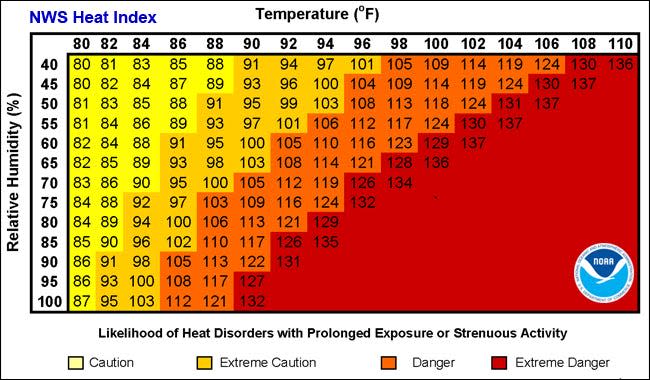Heat wave 2024: Delaware faces dangerous heat index levels as excessive heat watch looms
Delaware is moving into a dangerous heat wave with heat indexes expected to move above 100 degrees this week.
New Castle County residents, who are under a heat advisory until 6 a.m. Thursday and then an excessive heat watch until 8 p.m. Sunday, are wondering just how hot it's going to feel.
According to the National Weather Service, the maximum heat index forecast is calling for the heat index to break 100 this weekend. Here's a look at what's predicted for Wilmington:
Wednesday: The high is expected to hit the upper 80s with high humidity. The heat index will top out at 90.
Thursday: The high will reach the upper 80s with high humidity. The heat index will top out at 93.
Friday: The highs will reach the mid-90s with high humidity. The heat index will top out 100.
Saturday: The high will reach the mid-90s with humidity. The heat index will top out 100.
Sunday: The high will hit the mid-90s with high humidity. The heat index will top out 102
??Temps will cool down tonight into the 60s for most locations with partly cloudy skies.
??? Also are you wondering how hot it will "feel like" outside for the rest of the week into the weekend? Take a look below.#PAwx #DEwx #MDwx #NJwx pic.twitter.com/kyvWDVv5Zh— NWS Mount Holly (@NWS_MountHolly) June 18, 2024
While Kent and Sussex counties aren't facing excessive heat watches, a heat advisory may be issued for central and southern Delaware later in the week. The forecast is calling for temperatures in the 90s with high humidity for the central and southern parts of the state. A heat advisory is issued within 12 hours of extreme heat conditions. Typically, the heat index will be above 100 degrees and the nighttime air temperature will not drop below 75 degrees.
Delaware could receive a slight reprieve on Sunday night and Monday when storms move through the area, but highs are still expected to be in the 90s. There's a 40% chance of rain Sunday night and 30% chance on Monday.
What is heat index?
According to the National Weather Service, the heat index is what the temperature feels like to the human body when relative humidity is combined with the air temperature.
When the body sweats, the perspiration evaporates, cooling the body. When the humidity is high, the sweat doesn't evaporate as quickly and the body doesn't cool itself as well. Therefore, the body feels warmer. The heat index represents the heat you're feeling outside.
Here's a chart to help you find out what the heat index is. You can also use this heat index calculator.

What are signs of heat-related illnesses?
With extremely hot and humid weather, people need to be aware of several heat-related illnesses. According to the National Weather Service, here's what to watch for:
Heat cramps: Heat cramps are the first sign of heat-related illnesses. The symptoms include muscle cramps and spasms typically in the legs or abdomen. You should apply pressure on the cramping muscle or gently massage the muscle. The person should also try to sip water unless they are nauseous. If the cramps last more than an hour, the person should seek medical attention.
Heat exhaustion: A person who has heat exhaustion will sweat heavily, be tired, cool and clammy, have a weak, fast pulse, have muscle cramps, dizziness, nausea, headaches and may faint. Move the person to a cool area, loosen clothes and apply cool wet clothes or have the person sit in a bath. Offer water. If a person vomits more than once or symptoms worsen, seek immediate medical attention.
Heat stroke: The symptoms of heat stroke include a body temperature above 103 degrees, a throbbing headache, confusion, nausea, fainting or a loss of consciousness. Call 911 or get the person to a hospital immediately.
How to remain safe in the heat
With the extreme temperatures, here are some ways to stay safe.
Drink plenty of fluids.
Stay in an air-conditioned room.
Stay out of the sun.
Check up on relatives and neighbors.
Take extra precautions when outside.
Wear lightweight and loose-fitting clothing.
Try to limit strenuous activities to early morning or evening.
Take action when you see symptoms of heat exhaustion and heat stroke.
How to handle pets in the heat
If your pet is exposed to extreme heat, the AKC suggests getting your dog to a shady spot, applying ice packs under the dog's front legs on their chest, and pouring cold water over their head and body. Dogs should be given water to drink. A cooling mat for the dog to sit or stand on would be helpful as well.
In addition, according to the American Kennel Club, with temperatures 85 degrees or higher for a sustained period, dog owners need to be careful with hot asphalt, pavement and sand. The hot surface can cause blisters on your pet's paws.
This article originally appeared on Delaware News Journal: Heat wave 2024: Delaware heat indexes, excessive heat watch
